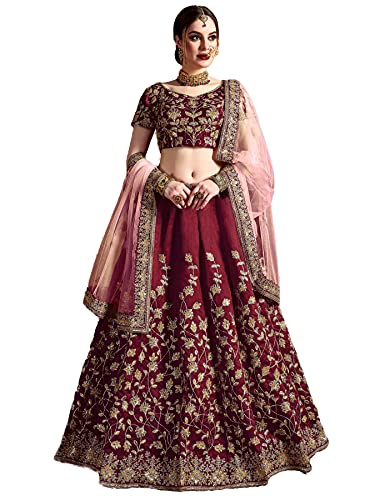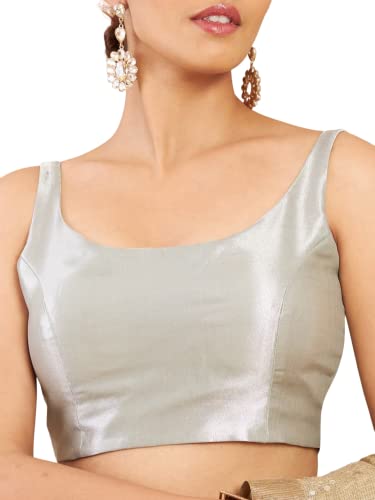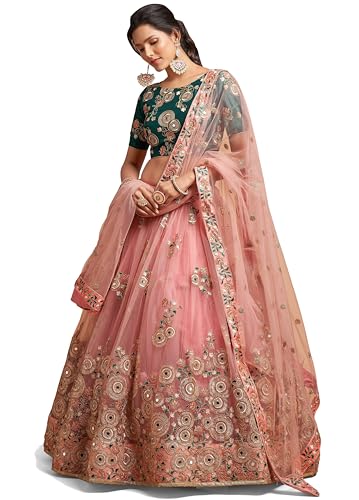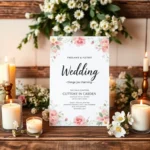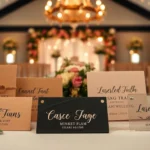Wedding season brings endless possibilities for brides-to-be searching for that perfect lehenga that’ll make their special day unforgettable. We’ve seen countless traditional designs grace wedding ceremonies but today’s modern brides are craving something extraordinary – unique lehenga designs that reflect their personality and create lasting memories.
From innovative silhouettes to unexpected color combinations we’re witnessing a beautiful revolution in bridal fashion. Contemporary designers are pushing boundaries by blending traditional craftsmanship with modern aesthetics creating stunning pieces that stand out from typical wedding wear. Whether you’re drawn to minimalist elegance or bold statement pieces there’s a distinctive lehenga waiting to transform your wedding vision into reality.
We’ll explore the most captivating unique lehenga design ideas that are taking the wedding industry by storm. These aren’t your grandmother’s traditional outfits – they’re fresh interpretations that honor heritage while embracing innovation making every bride feel like the confident radiant woman she truly is.
Traditional Lehenga Designs With Modern Twists
We’re witnessing a beautiful evolution where classic Indian silhouettes meet contemporary design elements. These fusion approaches create breathtaking lehengas that honor our cultural heritage while reflecting modern sensibilities.
Contemporary Embroidery Patterns on Classic Silhouettes
Contemporary embroidery transforms traditional lehenga silhouettes into modern masterpieces through innovative techniques and fresh interpretations. We see designers incorporating geometric patterns alongside traditional motifs like paisleys and florals. Digital embroidery techniques now create precise, intricate designs that weren’t possible with hand embroidery alone.
Laser cut appliqué work adds dimensional texture to classic A-line lehengas, creating stunning visual depth. Thread painting techniques blend traditional zardozi with modern color gradients for unique ombré effects. Contemporary sequin arrangements form abstract patterns that complement rather than compete with traditional mirror work.
Mixed media embroidery combines metallic threads with unconventional materials like pearls, crystals, and even fabric paint. These techniques create lehengas that photograph beautifully under modern lighting while maintaining their traditional elegance. Minimalist embroidery placement on classic cuts offers understated luxury for brides seeking refined sophistication.
Fusion of Regional Indian Styles
Fusion designs celebrate India’s diverse regional traditions by combining elements from different cultural backgrounds into single stunning pieces. We’re creating lehengas that merge Rajasthani mirror work with South Indian temple borders for truly unique aesthetic combinations. Gujarati bandhani patterns now appear alongside Bengali kantha stitching on contemporary silhouettes.
Punjab’s phulkari embroidery enhances Mysore silk lehengas, creating rich textural contrasts that honor multiple regional traditions. Kashmiri tilla work finds new expression when paired with Kanjeevaram borders on modern cut lehengas. These fusion approaches allow brides to celebrate their diverse heritage or simply appreciate India’s rich textile traditions.
Regional color stories blend seamlessly in these designs, with Rajasthani jewel tones complementing South Indian temple hues. Traditional weaving techniques from different states combine to create fabrics that tell multiple cultural stories. Modern construction methods ensure these fusion pieces maintain structural integrity while showcasing diverse regional elements.
Updated Color Palettes for Heritage Designs
Updated color palettes breathe fresh life into traditional lehenga designs while maintaining their timeless appeal and cultural significance. We’re moving beyond conventional reds and golds to embrace dusty roses, sage greens, and muted metallics that photograph beautifully. Millennial pink pairs surprisingly well with traditional gold zardozi work on classic lehenga shapes.
Monochromatic schemes in unexpected colors like deep emerald or sapphire blue create sophisticated alternatives to traditional palette choices. Gradient color transitions within single lehengas offer modern visual interest while preserving traditional silhouette integrity. Metallic accents in rose gold and champagne provide contemporary alternatives to yellow gold embellishments.
Earthy tones like terracotta, mustard, and burnt orange connect modern brides with nature while honoring traditional Indian color preferences. Jewel toned combinations featuring deep purples with copper accents create rich, luxurious appearances perfect for evening ceremonies. These updated palettes ensure heritage designs feel fresh and relevant for today’s discerning brides.
Unconventional Color Combinations for Wedding Lehengas

Modern brides are embracing bold color experiments that challenge traditional wedding palette expectations. These innovative combinations create stunning visual impact while maintaining the elegance that makes lehengas timeless.
Pastel and Neon Gradient Effects
Pastel hues dominate contemporary wedding fashion with their serene elegance and sophisticated appeal. Soft shades like blush pink, mint green, and lavender create a dreamy bridal aesthetic that photographs beautifully in natural light. Neon gradient effects transform traditional silhouettes into modern masterpieces by blending vibrant electric blues with soft pastels or combining hot pink with cream tones.
Gradient techniques allow designers to seamlessly transition from one shade to another across the lehenga’s fabric. Ombre effects starting with deep neon at the hem and fading to pale pastels at the waist create visual movement and contemporary flair. Color blocking methods incorporate distinct pastel and neon sections within the same garment for those who prefer defined color separation over gradual blending.
Metallic and Earth Tone Pairings
Terracotta and emerald combinations showcase how earthy warmth pairs beautifully with jewel tone richness. This sophisticated pairing creates depth while maintaining an organic feel that complements outdoor wedding venues. Brown and orange blends offer warm earth tones that radiate autumn elegance, particularly stunning when enhanced with gold threadwork or copper embellishments.
Metallic accents elevate earth tone lehengas through strategic placement of gold, silver, or rose gold elements. Bronze threading on rust colored fabric creates subtle luxury, while copper details on deep brown lehengas add unexpected glamour. Textural contrasts between matte earth tones and shimmering metallics provide visual interest without overwhelming the overall design aesthetic.
Monochromatic Schemes With Texture Variations
Single color palettes gain complexity through strategic texture manipulation rather than color variety. Different fabric weights within the same hue create subtle shadows and highlights that add dimensional beauty to monochromatic lehengas. Embroidery variations using the same color thread in different techniques like French knots, chain stitching, and mirror work create visual texture without introducing new colors.
Fabric mixing combines smooth silk with intricate lace or plush velvet within identical color families for sophisticated depth. Matte and glossy finishes of the same shade create contrast through light reflection rather than color difference. Layering techniques use sheer overlays, structured underskirts, and flowing dupattas in matching tones to build complexity while maintaining color harmony throughout the entire ensemble.
Innovative Fabric Choices and Textures

Modern wedding lehengas embrace revolutionary materials that transform traditional silhouettes into contemporary masterpieces. We’re witnessing a fabric revolution where unconventional choices create unique textures and unparalleled comfort for discerning brides.
Sustainable and Eco-Friendly Materials
Organic cotton leads the sustainable fabric movement, offering lightweight comfort with minimal environmental impact through reduced chemical processing. Bamboo silk delivers luxurious drape while maintaining biodegradability and natural breathability that keeps brides comfortable throughout lengthy ceremonies. Hemp provides surprising elegance with its refined texture and exceptional durability, making it perfect for heirloom lehengas that future generations can cherish.
Recycled materials revolutionize luxury bridal wear without compromising environmental values. Recycled silk maintains traditional opulence while reducing the ecological footprint of silk production by up to 70%. Recycled polyester offers versatility and affordability, allowing designers to create intricate embellishments without traditional synthetic production waste.
Ethical sourcing practices ensure fair labor conditions throughout the supply chain, supporting artisan communities while creating stunning bridal wear. Eco-friendly production processes minimize waste through efficient cutting techniques and responsible manufacturing methods that honor both craftsmanship and environmental stewardship.
Mixed Media and Layered Fabric Techniques
Layering creates dimensional beauty through strategic fabric combinations that add movement and visual interest. Organza paired with Tencel produces ethereal effects, where lightweight transparency contrasts with structured drape for dramatic silhouette enhancement. Chiffon combined with silk alternatives delivers romantic flow while maintaining sustainable principles that modern brides value.
Mixed media techniques incorporate non-fabric elements like pearls, beads, and digital prints to create multi-dimensional garments. Sequins embedded within fabric layers catch light from multiple angles, creating sparkle that photographs beautifully under various lighting conditions. Lace appliqués add textural contrast when layered over smooth base fabrics, providing depth without overwhelming the overall design.
Creative textile layering allows designers to experiment with weight distribution, ensuring comfort while achieving visual impact. Different fabric weights create natural movement patterns that enhance the bride’s graceful silhouette during ceremonial activities.
Unconventional Base Fabrics Beyond Silk and Velvet
Tencel emerges as a game-changing base fabric, offering exceptional softness and breathability while holding intricate embroidery with remarkable precision. Lyocell provides unique draping qualities that rival traditional silk while maintaining sustainable production methods that environmentally conscious brides appreciate. Handwoven blends combine multiple fiber types to create custom textures that can’t be replicated through mass production.
Upcycled polyester transforms discarded materials into luxurious bridal wear, proving that sustainability doesn’t require sacrificing elegance or traditional aesthetics. Viscose alternatives offer silk-like appearance with improved comfort and temperature regulation, making them ideal for warm weather ceremonies or destination weddings.
These innovative materials bring new tactile qualities to bridal fashion while maintaining the opulence that wedding lehengas demand. Lighter weight options provide all-day comfort without compromising the grandeur that makes lehengas so special for celebrating love and commitment.
Creative Silhouette Variations and Cuts

Modern bridal fashion embraces inventive shapes that transform the traditional lehenga silhouette into contemporary masterpieces. We’re witnessing designers push boundaries with fishtail, mermaid, and trumpet skirts that offer sophisticated alternatives to classic A-line cuts.
Asymmetrical Hemlines and Draping Styles
Asymmetrical designs dominate the 2025 wedding scene with uneven hemlines that create striking visual drama. We see lehengas featuring shorter fronts paired with longer backs, allowing brides to showcase beautiful wedding shoes while maintaining traditional elegance. Side-slit drapes add movement and sophistication, making each step a graceful dance.
Draped styles revolutionize how we think about lehenga construction through pleated overlays and layered skirts. These techniques create dimensional beauty that flows naturally with the bride’s movements. Cascading drapes from the waist create an ethereal effect that photographs beautifully during ceremony moments.
High-Low and Tiered Design Concepts
High-low lehengas capture attention with their notably shorter fronts and dramatically longer backs, perfect for brides seeking youthful energy. This design concept works exceptionally well for outdoor ceremonies where movement and comfort matter. We recommend these styles for destination weddings where versatility becomes essential.
Tiered constructions add texture through cascading layers and carefully placed ruffles that create volume without overwhelming petite frames. Multiple tiers allow designers to incorporate various embroidery patterns and fabric textures within a single garment. These statement pieces work beautifully for grand celebrations where dramatic impact is desired.
| Design Element | Visual Impact | Best For |
|---|---|---|
| High-Low Hemlines | Youthful, edgy vibe | Outdoor ceremonies |
| Tiered Layers | Textured volume | Grand celebrations |
| Cascading Ruffles | Dramatic movement | Photography sessions |
Cape and Jacket Style Additions
Detachable capes transform traditional lehengas into versatile ensembles that adapt throughout wedding festivities. We’re seeing lightweight organza capes for daytime ceremonies and heavily embroidered pieces for evening receptions. These additions provide coverage during religious ceremonies while allowing brides to reveal stunning choli designs later.
Jacket style cholis with long sleeves or deep V-necks add regal sophistication to modern bridal looks. Sheer overlays create layered elegance without adding bulk, while embellished jackets serve as statement pieces that complement rather than compete with the lehenga skirt. These contemporary touches blend seamlessly with traditional craftsmanship for truly unique wedding attire.
Statement Blouse Designs to Elevate Your Look

Modern bridal fashion continues to evolve with blouse designs that transform traditional lehengas into contemporary masterpieces. These innovative styles allow brides to express their personality while maintaining the elegance of classic Indian wear.
Off-Shoulder and Cold-Shoulder Variations
Off-shoulder blouse designs create an effortlessly romantic silhouette that complements the flowing nature of lehenga skirts. Contemporary designers create these necklines with structured bodices that provide support while showcasing the bride’s décolletage elegantly. Cold-shoulder variations offer a perfect balance between traditional coverage and modern appeal, featuring strategic shoulder cutouts that add visual interest without compromising comfort.
Brides seeking a modern twist on traditional wear find these designs particularly appealing for their versatility across different wedding ceremonies. The exposed shoulder line creates a graceful frame for statement jewelry pieces like chandelier earrings or delicate shoulder dusters. These variations work exceptionally well with both heavy embroidered lehengas and minimalist designs, allowing the blouse style to serve as the focal point of the ensemble.
Dramatic Sleeve Styles and Proportions
Puffed sleeves introduce volume and theatricality to lehenga blouses, creating a dramatic effect that balances beautifully with the skirt’s proportions. These voluminous designs draw inspiration from vintage silhouettes while incorporating contemporary tailoring techniques for optimal fit and comfort. Bell sleeves and long flared variations add romantic movement to the overall look, especially during ceremonial moments like walking down the aisle.
Structured sleeve designs with architectural elements create bold geometric shapes that complement modern embroidery patterns. Bishop sleeves gathered at the wrist offer a refined alternative to fuller puffed styles, providing drama without overwhelming petite frames. These proportional choices allow brides to customize their look based on their body type and personal style preferences while maintaining the traditional essence of lehenga wear.
Backless and Cut-Out Detail Innovations
Backless blouse designs revolutionize traditional lehenga styling by incorporating sophisticated cuts that create stunning visual impact from every angle. Deep back cuts with intricate tie details or decorative chains add contemporary flair while maintaining the garment’s structural integrity. These designs showcase the bride’s back beautifully, making them ideal for ceremonies where photography captures multiple perspectives.
Cut-out details strategically placed on the blouse create windows that highlight intricate embroidery work or beautiful skin. Side cut-outs, waist details, and keyhole necklines offer subtle ways to incorporate modern elements without compromising traditional aesthetics. These innovations work particularly well with metallic hues and contemporary colors, as the cut-out areas create interesting plays of light and shadow that enhance the overall design impact.
Unique Dupatta Styling and Alternatives

Modern brides are revolutionizing traditional dupatta styling with innovative approaches that complement contemporary lehenga designs. These creative alternatives offer fresh ways to complete your bridal look while maintaining elegance and cultural significance.
Creative Draping Techniques and Methods
Single shoulder draping creates an asymmetrical silhouette that perfectly complements modern lehenga cuts. Brides can drape the dupatta over one shoulder only, allowing it to cascade gracefully down one side while keeping the other shoulder bare for a contemporary twist.
Cape style draping transforms your dupatta into a dramatic statement piece by letting it flow from the back in a cape-like fashion. This technique works exceptionally well with lightweight fabrics like chiffon or tulle, creating movement and drama as you walk down the aisle.
Waistband tucking offers a streamlined effect that works beautifully with fitted lehengas. Tuck the dupatta into your waistband to create clean lines while maintaining the traditional element of your ensemble.
Sari inspired wrapping brings an elegant fusion approach by wrapping the dupatta around your torso in a sari style. This method creates beautiful draping that enhances your silhouette while offering a unique take on traditional styling.
Minimalist approach involves skipping the dupatta altogether for brides who prefer contemporary, clean looks. This styling choice works particularly well with heavily embroidered lehengas where the dupatta might compete with intricate detailing.
Statement Jewelry as Dupatta Replacements
Oversized chokers serve as dramatic alternatives to traditional dupattas, especially when paired with minimalist lehengas. These statement pieces add elegance without the bulk of fabric, creating a modern bridal aesthetic.
Layered necklaces create visual interest and replace the dupatta’s traditional role as a focal point. Multiple chains in varying lengths draw attention to the neckline while maintaining the grandeur expected in bridal jewelry.
Heavy maang tikkas become the centerpiece of your bridal look when you choose to forgo the dupatta. These elaborate head pieces add drama and traditional significance while keeping your overall silhouette clean and contemporary.
Shoulder jewelry offers an innovative replacement option that maintains coverage while eliminating fabric. These pieces drape across the shoulders like a dupatta would, creating similar visual weight through metalwork instead of textile.
Back jewelry creates stunning visual impact for backless blouse designs. These pieces draw attention to the exposed back area, replacing the dupatta’s traditional draping function with metallic artistry.
Layered and Multi-Dupatta Styling Ideas
Contrasting color layering involves using two or three dupattas in different colors to create a multidimensional effect. This trending technique allows brides to incorporate multiple hues from their wedding palette into a single ensemble.
Fabric contrast styling combines different textures for visual interest. Layer a sheer net dupatta over a heavier, embroidered one to create striking contrast that adds depth to your bridal look.
Veil and trail combination uses multiple dupattas where one serves as a traditional veil and others trail behind. This approach adds volume and regality to your ensemble while maintaining functionality for different ceremony moments.
Body wrapping technique involves draping additional dupattas around your body in various ways. One can wrap around your torso while another flows from your head, creating a complex yet elegant styling approach.
3D embellishment layering features dupattas with dimensional elements that create texture and movement. These embellished pieces work beautifully when layered with simpler fabrics, allowing the 3D details to become the focal point of your styling.
Modern Embellishment and Detailing Techniques

Modern bridal lehengas now showcase revolutionary embellishment approaches that transform traditional designs into contemporary masterpieces. We’ve witnessed a important shift in 2025 as designers embrace bold embroidery techniques with modern cuts, seamlessly blending heritage craftsmanship with avant garde aesthetics.
3D Floral and Sculptural Elements
Floral designs dominate the 2025 bridal lehenga industry through hand embroidered masterpieces and innovative digital prints that create fresh, playful aesthetics. We’re seeing designers incorporate raised petals, dimensional leaves, and layered botanical motifs that literally bloom from the fabric surface. Sculptural elements emerge through asymmetrical cuts and innovative silhouettes that offer brides an avant garde alternative to traditional designs.
Three dimensional embroidery techniques now feature graduated thread work, padded appliqués, and wire frame florals that create shadow play and movement with every step. We observe how these sculptural details transform static garments into ever-changing works of art that capture light beautifully during wedding ceremonies. Beadwork combines with fabric manipulation to achieve depth that photographs magnificently under both natural and artificial lighting conditions.
Geometric and Abstract Pattern Applications
Fusion lehengas revolutionize traditional silhouettes by incorporating geometric patterns through contemporary blouse designs paired with classic skirt styles. We find that angular motifs, chevron details, and tessellated patterns create striking visual contrast against flowing fabric drapes. Abstract interpretations of traditional paisley and mandala designs offer modern brides sophisticated alternatives that honor cultural heritage while embracing contemporary aesthetics.
Digital printing technology enables precise geometric applications that were previously impossible through hand embroidery alone. We’re witnessing laser cut appliqué work combined with geometric embroidery that creates multi layered visual complexity. Mathematical precision meets artistic expression through carefully calculated pattern placements that enhance the bride’s silhouette while maintaining cultural authenticity.
Mirror Work and Reflective Detail Innovations
Metallic accents define 2025 bridal fashion through innovative mirror work applications that create futuristic, eye catching elements across lehenga designs. We observe how traditional mirror work now combines with metallic fabrics to produce bold, stylish looks that capture and reflect venue lighting dramatically. Reflective sequins, metallic threads, and holographic elements work together to create ever-changing surface textures that shift with movement.
Mirror work enhancements transcend traditional applications through strategic placement and size variation that creates sophisticated light patterns. We’re documenting how contemporary designers use mirrors as architectural elements, building geometric frameworks that structure the entire garment design. Combination techniques merge traditional mirror work with modern reflective materials like chrome finished beads and iridescent fabrics that amplify the overall luminous effect.
Destination Wedding Lehenga Adaptations

Modern destination weddings require lehengas that seamlessly blend cultural authenticity with the venue’s unique ambiance. We’re seeing designers expertly incorporate local motifs and destination-inspired elements to create truly personalized bridal ensembles.
Beach and Outdoor Ceremony Considerations
Beach ceremonies demand lehengas with shorter hemlines that prevent fabric from dragging in sand while maintaining elegance. Layered organza and chiffon skirts create ethereal movement that complements ocean breezes and natural lighting conditions.
Breathable blouse designs accommodate humidity while strategic embellishment placement ensures comfort throughout extended outdoor ceremonies. Pastel shades and ombré effects capture the serene beauty of coastal settings while sheer overlays add dimension without overwhelming the natural backdrop.
Minimal embellishments prevent discomfort when sitting on sand or grass during outdoor rituals. Designers are prioritizing lightweight construction that allows brides to move freely across uneven terrain while maintaining their regal appearance.
Climate-Appropriate Fabric and Design Choices
Georgette and organza fabrics provide essential breathability for hot climate weddings while maintaining beautiful draping qualities. Lightweight silks offer luxury without the weight burden that traditional heavy fabrics create in warm destinations.
Cooler destinations call for velvet or silk blends paired with layered dupattas that add warmth without sacrificing style. We recommend reducing embellishments in humid or sandy environments to maintain both comfort and practicality throughout the celebration.
Fabric selection directly impacts the bride’s comfort and the lehenga’s performance in different weather conditions. Strategic fabric combinations allow for temperature regulation while preserving the outfit’s visual impact and cultural significance.
Travel-Friendly and Versatile Styling Options
Detachable elements revolutionize destination wedding lehengas by offering incredible versatility for different ceremony phases. Removable dupattas and adjustable waistbands allow seamless transitions from intimate ceremonies to grand receptions.
Convertible blouses and mix-and-match sets maximize outfit combinations while minimizing luggage space. Modular embroidery and reversible fabrics provide multiple styling options without requiring additional garments.
Wrinkle-resistant materials ensure lehengas arrive in perfect condition regardless of travel duration or packing constraints. Packing-friendly silhouettes maintain their shape while accommodating the practical demands of destination wedding logistics.
Conclusion
We’ve witnessed how contemporary bridal fashion is revolutionizing traditional lehenga designs while preserving their cultural essence. These innovative approaches to colors textures and silhouettes offer endless possibilities for brides who want to make a statement on their special day.
The beauty of modern lehenga design lies in its versatility and personalization options. Whether you’re drawn to sustainable fabrics bold embellishments or unconventional cuts there’s a design that perfectly captures your unique style and vision.
As we move forward these creative interpretations ensure that lehengas remain a timeless choice for modern brides. By embracing these unique design ideas you’ll create unforgettable memories while honoring the rich traditions that make Indian bridal wear so magnificent.
Frequently Asked Questions
What makes modern lehenga designs different from traditional ones?
Modern lehenga designs blend traditional craftsmanship with contemporary aesthetics. They feature innovative silhouettes like fishtail and mermaid cuts, unconventional color combinations beyond traditional reds and golds, contemporary embroidery techniques including geometric patterns and laser-cut appliqué work, and sustainable fabric choices. These designs honor heritage while embracing current fashion trends and bride preferences.
What are the trending color combinations for wedding lehengas in 2025?
Modern brides are embracing bold color experiments including pastel and neon gradients, metallic and earth tone pairings like terracotta with emerald, and sophisticated monochromatic schemes. Popular modern shades include dusty roses, sage greens, and unexpected combinations that create visual depth while maintaining elegance for contemporary wedding celebrations.
What sustainable fabric options are available for eco-conscious brides?
Eco-friendly lehenga options include organic cotton, bamboo silk, hemp, Tencel, and upcycled polyester. These sustainable materials offer comfort, minimal environmental impact, and maintain luxury aesthetics. Recycled materials and ethical sourcing practices ensure fair labor conditions while creating beautiful, environmentally responsible bridal wear that doesn’t compromise on style or quality.
How can I style my lehenga differently with innovative blouse designs?
Modern blouse variations include off-shoulder and cold-shoulder styles for romantic appeal, dramatic puffed or bell sleeves for volume and movement, and backless or cut-out details for stunning visual impact. These innovative designs allow brides to express their personality while maintaining elegance and creating unique looks that complement contemporary lehenga silhouettes.
What are creative alternatives to traditional dupatta styling?
Modern dupatta alternatives include single shoulder draping, cape-style draping, or going dupatta-free with statement jewelry. Multi-dupatta layering with contrasting colors and fabrics creates innovative looks. These contemporary approaches allow brides to maintain cultural significance while adapting traditional elements to suit their personal style and modern wedding aesthetics.
How should I choose a lehenga for a destination wedding?
Consider your venue’s climate and setting when selecting destination wedding lehengas. For beach ceremonies, choose shorter hemlines and breathable fabrics like georgette. Hot climates require lightweight materials, while cooler destinations suit velvet blends. Opt for travel-friendly designs with detachable elements and wrinkle-resistant fabrics to ensure practicality without sacrificing elegance.
What embellishment techniques are trending in modern lehenga designs?
Contemporary embellishment trends include 3D floral elements, sculptural details, geometric patterns, and digital printing technology. Metallic accents and innovative mirror work create futuristic touches. These techniques transform traditional lehengas into contemporary masterpieces, offering sophisticated alternatives to conventional embroidery while maintaining cultural authenticity and visual impact.





